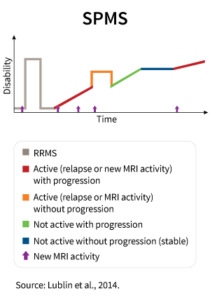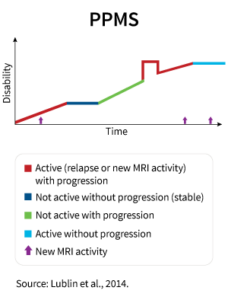Multiple Sclerosis (MS) is a chronic neurological condition that affects the central nervous system. The result of damage to the myelin and nerve fibers in the central nervous system (CNS), MS can cause a wide range of symptoms, including fatigue, muscle weakness, numbness or tingling in the limbs, and problems with coordination. Each person develops a unique set of MS symptoms, so every individual’s experience of MS is different.
While there is currently no all-around cure for MS, the use of yoga therapy is a proven method of mitigating symptoms of MS. In this blog post, I’ll share some recent research on yoga therapy for MS. When working with clients struggling with MS, I recommend a longer-term commitment. Usually, sessions will be closer together at first, then spaced out to about once a month later on in our work together.
What Are the Symptoms of Multiple Sclerosis?¹’²’³’⁴
First symptoms of Multiple sclerosis
- Vision problems that could include blurred or double vision, Optic neuritis, neuromyelitis optica, poor contrast or color vision, and pain on eye movement
- Red-green color distortion
- Numbness or tingling
- MS Hug (Dysesthesia), a “squeezing sensation around the torso”⁵
Other symptoms of Multiple sclerosis
- Muscle weakness
- Headache
- Walking and coordination difficulties
- Spasticity, feelings of stiffness and involuntary muscle spasms
- Fatigue
- Dizziness and vertigo
- Emotional changes that may include anxiety, mood swings, irritability, and episodes of uncontrollable laughing and crying
- Electric-shock sensations that occur with certain neck movements, especially bending the neck forward (Lhermitte sign)
- Bowel and bladder problems
- Depression
- Changes in sexual function
- Slurred speech
- Cognitive changes that may affect focus, attention, judgment, and memory
- Pain and itching
Less Common Symptoms of Multiple sclerosis
- Loss of sensation, such as taste
- Speech problems
- Tremor
- Swallowing problems
- Breathing problems
- Hearing loss
- Seizures
Secondary Symptoms of Multiple sclerosis
The symptoms I listed above are the primary symptoms of Multiple sclerosis. The following secondary symptoms are “the complications that can arise as a result of these primary symptoms.”⁶ Yoga therapy intervention may help prevent secondary symptoms from developing.⁷ This is exemplified by a study published in 2012, by Patil et al., that showed significant improvement in bladder symptoms in MS patients after integrated yoga treatment.⁸
- A dysfunctional bladder can lead to urinary tract infections.
- Loss of muscle tone, weakness, poor posture, decreased bone density and shallow breathing can all stem from inactivity.
- Immobility can lead to pressure sores.
These secondary symptoms can be treated, but it’s far better to treat the primary symptoms before secondary symptoms can develop. In yoga therapy sessions with clients dealing with MS, I often give them physical postures and breathing exercises as part of the treatment plan so that inactivity and immobility are less likely.
A Yoga Therapist’s Perspective on the Progression of Multiple Sclerosis
As a yoga therapist, I know getting diagnosed with MS can be scary, and I’m here to help clients work through the uncertainty. I recognize that having a comprehensive awareness and cognitive understanding of the disease is important for MS clients. Emotions, such as fear and frustration, may arise from experiencing symptoms and during treatment, and I work with clients to acknowledge those difficult emotions.
There are four main types of Multiple sclerosis, each occurring at a different point in time during the potential progression of MS symptoms. Due to the progressive nature of MS, including yoga therapy in a treatment plan is often imperative to help people cope with the day-to-day experience of the disease.
In the course of the disease, immune system cells, usually crucial for fending off viruses and bacteria, start to attack the protective sheath around nerve fibers in the brain, optic nerves, and spinal cord. Also, “the outermost layer of the brain, called the cerebral cortex, shrinks in a process known as cortical atrophy.”⁹
Many people with relapsing-remitting MS (RRMS) do not develop a steady progression of symptoms. However, from 20% to 40% “of those with relapsing-remitting MS can eventually develop a steady progression of symptoms, with or without periods of remission, within 10 to 20 years from disease onset.”¹⁰ Known as secondary-progressive MS, this course can include mobility and gait challenges.
From there, some people with MS will develop progressively worse neurological function, which is a course of the disease known as primary-progressive MS.
Read on to learn more about each type of MS.
Clinically Isolated Syndrome (CIS)
CIS occurs when you have at least one “episode of neurologic symptoms like those in MS.”¹¹
Relapsing-remitting MS (RRMS)
This is the most common disease course, and each person’s experience of RRMS is different. In RRMS, attacks occur, followed by partial or complete recovery, or remission.

Secondary progressive MS (SPMS)
MS is considered to be SPMS when neurologic function worsens progressively following the initial relapsing-remitting course.

Primary progressive MS (PPMS)
This is a more rare disease course in which “neurologic function worsens or disability accumulates as soon as symptoms appear, without early relapses or remissions.”¹²

What Are the Benefits of Yoga Therapy for Multiple Sclerosis?
Yoga therapy involves the use of individualized yoga practices, such as postures, breathing exercises, and meditation, tailored to meet the needs of each person. Here are some of the ways that yoga therapy can help mitigate symptoms of MS:
1) Improving balance and coordination
MS can cause problems with balance and coordination, which can affect daily activities and increase the risk of falls. Yoga therapy includes specific postures and movements that focus on improving balance and coordination, such as standing poses and balance exercises.
A specific type of physical posture that I use with MS clients involves the use of cross-body work to maintain and strengthen the brain-body connection.

Locust Pose
An example of using a yogic posture for cross-body work.
2) Reducing fatigue
Fatigue is one of the most common symptoms of MS and can be debilitating. Not to be confused with just feeling worn out, “the fatigue experienced by people with MS is very different than the exhaustion that a healthy individual might experience.”¹³
I integrate fatigue mitigation techniques in yoga therapy in a couple of ways. One example of this in my yoga therapy work is guiding clients through yoga nidra, a specific type of meditation. Yoga nidra provides crucial constructive rest to combat fatigue.
Another way I help clients mitigate symptoms of fatigue from MS is by teaching people how to practice physical postures so they can start to become aware of how much effort they are putting in at any time. Through practicing yoga in a therapeutic setting, clients start to understand the amount of effort and energy needed to carry out the tasks and chores of daily living. This tends to positively shift the way they perceive themselves functioning in the world.
This work on mitigating fatigue with yoga therapy is supported by research, such as this 2004 study concluding that yoga is “effective in relieving fatigue in MS patients.”¹⁴
3) Maintaining strength
A common symptom of MS is muscle weakness and loss of muscle tone. According to an article by Palukuru et al., “the beneficial effects of yoga in patients with MS point to an improvement in body flexibility and muscular strength.”¹⁵ To help mitigate this MS symptom, I often work with yoga therapy clients to practice physical postures that help maintain strength.
Rather than isolate specific muscle groups, as is common in physical therapy, I work with yoga therapy clients on postures that can help maintain strength across the entire body. Targeted physical therapy work can be very useful, but yoga therapy is unique in that it provides support for the whole body-mind system.
4) Managing spasticity and muscle tension
MS can cause spasticity, a condition in which muscles become stiff and difficult to move. Yoga therapy can include postures and movements that help to release muscle tension and improve flexibility, reducing spasticity and improving range of motion.
For example, I often teach clients with MS how to physically transition in and out of a yoga pose to increase blood flow to muscles, followed by stretching that area.
5) Maintaining emotional and physical stability
MS not only can cause pain, including neck pain, emotional pain, and neuropathic pain, but it can also lead to disruptive instability in life. This is why I work both pain management and stabilizing practices into my yoga therapy work with clients.
Yoga therapy not only may “lead to clinically meaningful reductions in pain interference scores, and mindfulness meditation has been shown to be effective for pain reduction”¹⁶ but also helps clients work through the difficult emotions that may arise while experiencing MS symptoms.
As clients decide between medications, experiment with different diets, and adjust their lifestyle to work with and around their MS, I provide accountability and stability for them throughout. I also guide clients through techniques to cope with pain in yoga therapy sessions, including gentle stretching, healthy breathing techniques, and mindfulness practices.
Additionally, careful pacing of physical postures is very important when I work with yoga therapy clients with MS. I teach physical postures in a way that helps them understand their own sense of effort. I guide clients in answering the following questions for themselves:
- Can I still practice the pose without going 100%?
- How can my working pace for this pose translate to the effort I put into my daily life?
6) Reducing stress and anxiety
Living with a chronic condition like MS can be stressful and anxiety-inducing. In yoga therapy, I facilitate practices that can help to calm the mind, including breathing, as well as chanting and meditation. How do these techniques actually help mitigate MS symptoms?
First, breathing regulates the nervous system, therefore assisting in reducing stress and anxiety in clients struggling with MS.
Second, chanting and meditation help quiet the mind and break up patterns of thought. MS can be very challenging to deal with as a degenerative disease, and difficult thoughts and emotions might come up. Meditation and chanting can create some much-needed space to deal with any fear, anxiety, and stress that might come up.
Yoga Therapy Practices for Mitigating Symptoms of Multiple Sclerosis
Yoga therapy can be a valuable tool for managing symptoms of MS and improving overall quality of life. If you have MS, it is important to work with a qualified yoga therapist who can create an individualized practice tailored to your specific needs and limitations.
With regular practice, yoga therapy can help to improve balance and coordination, reduce fatigue and muscle tension, manage pain, and promote a more mindful approach to dealing with the disease.
This is why I offer my clients micro-practices to be used throughout the day. With micro-practices, they can stay consistent with practicing without getting overwhelmed or stressed. Micro-practices may include:
- 5 minutes of breathing
- 5 minutes of chanting
- 3 postures to practice 3 times per day
- Etc.
Why is Yoga Therapy a Good Option for MS?
In a group yoga class, it’s sometimes difficult to get the individual attention you need, especially when you’re dealing with the challenges of MS. Our bodies are all different, and each of us comes to yoga with unique experiences and growth points. That’s why I center my yoga therapy sessions on individualized attention and care, making sure that our work is tailored to you and your body.
Specializing in autoimmune conditions and chronic illnesses, I am a certified yoga therapist offering yoga therapy through Yoga Therapy Associates in New Haven, Connecticut and online.
I’d love to talk with you about how yoga therapy can help with your specific symptoms. You can book an initial consultation here.
Sources
- Multiple sclerosis (MS). Multiple Sclerosis (MS) – Health Encyclopedia – University of Rochester Medical Center. (n.d.). Retrieved April 3, 2023, from https://www.urmc.rochester.edu/encyclopedia/content.aspx?contenttypeid=85&contentid=P00790
- Symptoms & diagnosis. National Multiple Sclerosis Society. (n.d.). Retrieved April 3, 2023, from https://www.nationalmssociety.org/Symptoms-Diagnosis
- Frank, R., & Larimore, J. (2015). Yoga as a method of symptom management in multiple sclerosis. Frontiers in Neuroscience, 9. https://doi.org/10.3389/fnins.2015.00133
- Mayo Foundation for Medical Education and Research. (2022, December 24). Multiple sclerosis. Mayo Clinic. Retrieved April 3, 2023, from https://www.mayoclinic.org/diseases-conditions/multiple-sclerosis/symptoms-causes/syc-20350269
- MS symptoms. National Multiple Sclerosis Society. (n.d.). Retrieved April 3, 2023, from https://www.nationalmssociety.org/Symptoms-Diagnosis/MS-Symptoms
- Symptoms & diagnosis. National Multiple Sclerosis Society. (n.d.). Retrieved April 3, 2023, from https://www.nationalmssociety.org/Symptoms-Diagnosis
- Rogers, K. A., & MacDonald, M. (2015). Therapeutic yoga: Symptom management for multiple sclerosis. The Journal of Alternative and Complementary Medicine, 21(11), 655–659. https://doi.org/10.1089/acm.2015.0015
- Rogers, K. A., & MacDonald, M. (2015). Therapeutic yoga: Symptom management for multiple sclerosis. The Journal of Alternative and Complementary Medicine, 21(11), 655–659. https://doi.org/10.1089/acm.2015.0015
- U.S. Department of Health and Human Services. (n.d.). Multiple sclerosis. National Institute of Neurological Disorders and Stroke. Retrieved April 3, 2023, from https://www.ninds.nih.gov/health-information/disorders/multiple-sclerosis
- Mayo Foundation for Medical Education and Research. (2022, December 24). Multiple sclerosis. Mayo Clinic. Retrieved April 3, 2023, from https://www.mayoclinic.org/diseases-conditions/multiple-sclerosis/symptoms-causes/syc-20350269
- Clinically isolated syndrome (CIS). National Multiple Sclerosis Society. (n.d.). Retrieved April 3, 2023, from https://www.nationalmssociety.org/What-is-MS/Types-of-MS/Clinically-Isolated-Syndrome-(CIS)
- Types of multiple sclerosis. National Multiple Sclerosis Society. (n.d.). Retrieved April 3, 2023, from https://www.nationalmssociety.org/What-is-MS/Types-of-MS
- Staff, B. N. (2021, December 10). Expert voices: Understanding and managing multiple sclerosis fatigue. Multiple Sclerosis News Today. Retrieved April 3, 2023, from https://multiplesclerosisnewstoday.com/expert-voices/2021/09/30/expert-voices-understanding-managing-ms-fatigue/
- Mishra, S. K., Singh, P., Bunch, S. J., & Zhang, R. (2012). The therapeutic value of yoga in neurological disorders. Annals of Indian Academy of Neurology, 15(4), 247. https://doi.org/10.4103/0972-2327.104328
- Palukuru, S., Patil, S. S., Nagarathna, R., Singh, A., & Nibedita, K. S. (2021). Content validity of an integrated yoga module for practice during remission in relapsing–remitting multiple sclerosis patients. Annals of Neurosciences, 28(1-2), 29–38. https://doi.org/10.1177/09727531211023754
- Lakin, L., Davis, B. E., Binns, C. C., Currie, K. M., & Rensel, M. R. (2021). Comprehensive approach to management of multiple sclerosis: Addressing invisible symptoms—a narrative review. Neurology and Therapy, 10(1), 75–98. https://doi.org/10.1007/s40120-021-00239-2
